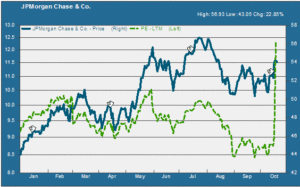
What is a stock index? Essentially, nothing more than a relationship between the aggregate earnings of a group of companies and the price which investors are willing to pay to purchase those earnings. That relationship is expressed in the price-to-earnings (P/E) ratio. If XYZ Company’s net income for the last twelve months is $1 per share and the current stock price is $10, then investors are willing to pay $10 for every dollar of XYZ earnings – a P/E ratio of 10x. As new information comes into the public sphere, that new information will impact this relationship between price and earnings. Maybe XYZ Company is a biotech firm that just developed a revolutionary new therapy for a serious disease. So now investors are willing to pay $12 for every dollar of earnings, and the price of XYZ stock jumps 20% to $12. In theory, at least, that’s the way the stock market is supposed to work. It’s the basis of the efficient market hypothesis (EMH) taught to every aspiring financial professional.
Through the Looking Glass
The EMH, however useful it may be as a conceptual framework, breaks down in the messier, increasingly surreal world of day to day market trends and movements. Consider the following chart. This is the year-to-date stock price performance of JPMorgan, along with the LTM (last twelve months) P/E ratio:

The chart shows that, over the course of this year, JPMorgan stock trended upwards, with occasional pullbacks, while the P/E ratio fluctuated gradually as investors digested new information about earnings, litigation, the external economic context and other factors. Suddenly we see that, after the latest earnings release on October 11, the stock price rises sharply while the P/E ratio…well, the P/E goes through the roof. What’s this all about?
Bad News Is Bad, Except When It’s Good
Recall that for many months now, JPMorgan has been involved with the negative fallout from a rogue trader, known as the “London Whale”, whose perfidy in the derivatives market caused losses for the firm measuring in the hundreds of millions of dollars. Well, in their October 11 earnings statement, JPMorgan revealed a whale of an earnings surprise. The firm incurred a third quarter loss of $380 million as the accumulated litigation costs associated with the London Whale reached $9.2 billion – a much higher figure than had been anticipated. The market’s response to this decisively negative surprise was…to buy JPM stock like crazy! The P/E ratio went literally overnight from 45 to 56 because the numerator in the equation went way up and the denominator (the earnings) went way, way down. Investors essentially said this: “Yesterday I was willing to pay $45 dollars for every dollar of JPM earnings. Today, though, I found out that the company’s litigation mess is even worse than I had thought. So…today I’ll pay 56 dollars for each dollar of those earnings!”
Method in the Madness
Crazy, right? Well, there’s actually some method in the madness. We see this not just in counterintuitive responses to earnings surprises, but also in how asset prices react to all sorts of things; from the near-miss with the debt ceiling to parsing the monthly Fed minutes and so forth. The obvious outcome – a stock will go down if something bad happens – may not be so obvious after all. Maybe investors were relieved that the litigation wasn’t worse than $9.2 billion – a figure that while onerous doesn’t threaten to put the giant bank out of business. Maybe some giant high frequency trading algorithm was programmed to unleash a torrent of buy orders if the litigation came in anywhere less than $10 billion. Anything’s possible.
The important point is that this is the way markets work in this day and age. The fundamental relationship between price and value matters, but it’s far from the only thing that drives daily stock prices – contra the Efficient Market Hypothesis – and sometimes it doesn’t seem to matter at all. This knowledge is power. It facilitates the development of market strategies that allow for and anticipate spasms of irrationality as asset prices seek out and converge on value. Maybe markets aren’t supposed to work this way. But they do. If you’re in the business of managing money, you need to acknowledge and deal with that reality.